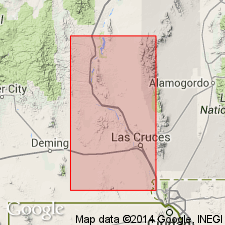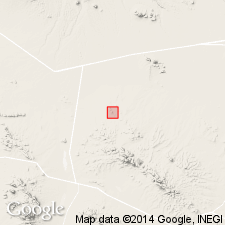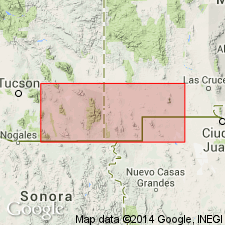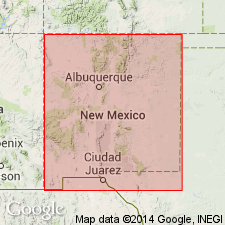
- Usage in publication:
-
- Box member
- Modifications:
-
- Principal reference
- Dominant lithology:
-
- Shale
- Limestone
- AAPG geologic province:
-
- Orogrande basin
Stevenson, F.V., 1945, Devonian of New Mexico: Journal of Geology, v. 53, no. 4, p. 217-245.
Summary:
Pg. 241, 243, figs. 2, 13; F.V. Stevenson, 1944, Dallas Digest (AAPG, SEPM, SEG Joint Mtg), p. 95. Box member of Percha shale. Commonly composed of gray to green calcareous shales with intercalated lenses and nodules of limestone. Becomes progressively more calcareous to the west of Hillsboro; on Bear Mountain, northwest of Silver City, interbedded in shale are many massive beds of limestone, one attaining maximum of 16 feet. Total thickness 46.5 feet. In upper part of Percha shale. Overlies Ready Pay member (new) with gradational contact. Unconformably underlies Lake Valley limestone. Age is Late Devonian. Origin of name given.
Named from "The Box," the narrow canyon in Mimbres Mountains through which Percha Creek flows eastward into Rio Grande, 2.5 mi southeast of Hillsboro, in SW/4 SW/4 SE/4 sec. 14, T. 16 S., R. 7 W., Sierra Co., southwestern NM.
Source: Modified from US geologic names lexicon (USGS Bull. 1200, p. 445).

- Usage in publication:
-
- Box Member*
- Modifications:
-
- Overview
- AAPG geologic province:
-
- Basin-and-Range province
Summary:
Is upper member of Percha Shale (Upper Devonian) in Klondike Hills, Grant and Luna Counties, New Mexico, in southeastern part of Basin-and-Range province. Disconformably underlies Keating Formation of Escabrosa Group. Upper 100 feet exposed in outcrop. Poorly preserved fossil brachiopod fauna identified; assemblage apparently represents part of fauna that Bowsher (1967) considered typical Box, and characteristic of the Famennian. Age is Late Devonian (Famennian).
Source: Modified from GNU records (USGS DDS-6; Denver GNULEX).

- Usage in publication:
-
- Box Member*
- Modifications:
-
- Age modified
- Biostratigraphic dating
- AAPG geologic province:
-
- Pedregosa basin
Summary:
Is uppermost member of Percha Shale in Pedregosa basin, Hidalgo County, New Mexico. Collection of brachiopods, from less than a meter below the nonconformable upper contact with Bugle Member (new) of Keating Formation, identified by J. Thomas Dutro, Jr. (USGS loc. 9205-SD), indicates a probable middle Famennian (Late Devonian) age. Brachiopod fossils listed.
Source: Modified from GNU records (USGS DDS-6; Denver GNULEX).

- Usage in publication:
-
- Box Member*
- Modifications:
-
- Revised
- AAPG geologic province:
-
- Pedregosa basin
Summary:
Is uppermost member of Percha Shale (Upper Devonian) in central Peloncillo Mountains, Hidalgo County, New Mexico, in Pedregosa basin. Overlies Ready Pay Member of Percha Shale. Unconformably underlies Keating Formation (Lower Mississippian) of Escabrosa Group (raised in rank). Age is Late Devonian; [apparently on basis of previous work].
Source: Modified from GNU records (USGS DDS-6; Denver GNULEX).

- Usage in publication:
-
- Box Member*
- Modifications:
-
- Overview
- AAPG geologic province:
-
- Orogrande basin
- Basin-and-Range province
Summary:
Is the upper member of the Percha Formation. Gradationally overlies [Ready Pay] Member of Percha. Basal contact placed at base of 10 foot-thick shale with limy nodules; basal unit has many brachiopods. Disconformably underlies Mississippian Caballero Formation. Caballero rocks are yellow-weathering, calcareous siltstone with phosphate pebbles, conodonts, and trace fossils. Usually a lag pebble conglomerate bed with late Kinderhookian conodonts found at basal contact. Present in the Hillsboro area, Sierra County (Orogrande basin) and the Silver City area, Grant County (Basin-and-Range province), New Mexico. Ranges between 30 and 50 feet thick. Thins westward. Is dominantly shale, but becomes more calcareous westward; increase of limy nodules and thin beds of limestone. Has yielded diverse fauna, e.g., horn corals, bryozoans, mollusks, echinoderms, but mostly brachiopods. Thirty genera and 44 species identified. Age is Late Devonian (late Famennian). Report includes faunal list, correlation charts, cross sections.
Source: Modified from GNU records (USGS DDS-6; Denver GNULEX).
For more information, please contact Nancy Stamm, Geologic Names Committee Secretary.
Asterisk (*) indicates published by U.S. Geological Survey authors.
"No current usage" (†) implies that a name has been abandoned or has fallen into disuse. Former usage and, if known, replacement name given in parentheses ( ).
Slash (/) indicates name conflicts with nomenclatural guidelines (CSN, 1933; ACSN, 1961, 1970; NACSN, 1983, 2005, 2021). May be explained within brackets ([ ]).

